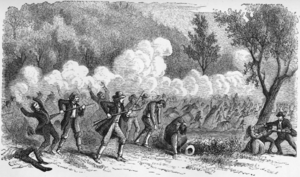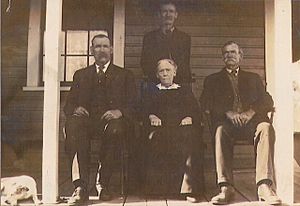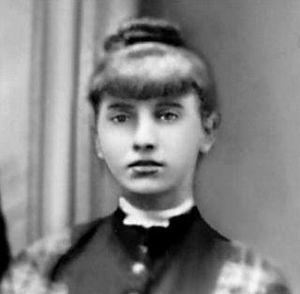Baker–Fancher party facts for kids

The Baker–Fancher party was a group of American settlers traveling west from Arkansas in 1857. They were on their way to California when they were attacked near Cedar City in Utah Territory. This terrible event is known as the Mountain Meadows Massacre. Around 120 to 140 men, women, and children were killed on September 11, 1857, at Mountain Meadows. Only 17 young children, all under the age of seven, survived the attack. These children were taken in by local families, likely because they were too young to remember and tell what happened.
Contents
Journey to Utah
The Baker–Fancher party was actually made up of several smaller groups. They started their journey separately from different parts of Arkansas in April 1857 and then joined together. Many of these families were successful farmers and cattle ranchers. They had enough money and supplies for the long trip west. Some had family waiting for them in California, and many relatives stayed behind in Arkansas.
Two main groups were the Baker train, led by Captain John Twitty Baker, and the Fancher train, led by experienced traveler Alexander Fancher. Other groups also joined them. One leader, Pleasant Tackitt, was a minister who held worship services during their journey. When they left Arkansas, the total group was over 200 people. However, some groups left the main party, and others joined along the way.
The travelers were well-prepared with wagons, carriages, and a large herd of almost 1,000 cattle. They also had many oxen and horses. People joined the trip for different reasons: some wanted to live in California, some wanted to sell cattle for money, and some hoped to find gold. Like other groups traveling west, they carried money and planned to buy more supplies in Salt Lake City. They arrived in the Salt Lake area in early August 1857, needing more supplies for the rest of their journey.
Families Who Left the Party
As the wagon train traveled, some families decided to go to other places or left the main group before reaching Utah. None of these families shared the same sad fate as those who continued to Mountain Meadows.
- Smith
- Morton
- Hudson
- Basham
- Haydon
- Reed
- Stevenson
- Hamilton
- Farmer
- Lafoon and/or Laffoon
- Poteet – cousins to the Tackitt family (they left and went to Texas the day before the massacre)
Some families also separated from the group while they were traveling through Utah Territory:
- Eaton, William M.
- Edwards, Silas
- Rush, Milum L.
- Stallcup, Charles
- The John R. Page Family
The Attack at Mountain Meadows
In the early morning of Monday, September 7, the Baker–Fancher party was attacked at their camp in Mountain Meadows. The attackers were about 200 Mormon militiamen, who were dressed to look like Native Americans. Some accounts say Paiutes were also involved, but some survivors later said this was not true.
The attackers hid in a small ditch near the camp. When they started shooting, the Baker–Fancher party quickly defended themselves. They circled their wagons, dug shallow trenches, and piled dirt for protection. Seven settlers were killed in this first attack, and 16 more were hurt. The attack lasted for five days. During this time, the families had very little fresh water, and their ammunition ran out.
On Friday, September 11, 1857, two Mormon militiamen came to the wagons holding a white flag. They were soon followed by John D. Lee, a militia officer. Lee told the tired settlers that he had made a deal with the Paiutes. He said the settlers could be safely taken 36 miles back to Cedar City under Mormon protection. In return, they had to give all their livestock and supplies to the Native Americans.
The settlers agreed and left their protected camp. But when a signal was given, the Mormon militiamen turned and killed the men of the Baker–Fancher party who were walking beside them. According to some Mormon stories, the militia then let a group of Paiute Indians kill the women and children. The bodies were gathered and robbed, then left in shallow graves or on the ground. The Mormon militia members were sworn to secrecy, and a plan was made to blame the massacre on the Native Americans.
Seventeen small children, all under seven years old, were not killed. They were thought to be too young to remember what happened. These children were taken in by local Mormon families. Later, the U.S. Army found the children and returned them to their relatives.
Brigham Young, a leader in the area, reportedly received a letter about the Baker–Fancher party on the same day of the massacre. This letter asked for his advice on what to do with the group. When he learned what was planned, he sent a letter saying the Baker–Fancher party should be allowed to pass through safely. However, Young's letter supposedly arrived two days too late, on September 13, 1857. Some historians, like Jon Krakauer, claim that Brigham Young and other officials encouraged the massacre before it happened and tried to hide their involvement afterward.
Some of the settlers' belongings were taken by the Native Americans involved. However, large amounts of cattle and personal items were taken by the Mormons in Southern Utah. John D. Lee took charge of the livestock and other property. Some cattle were taken to Salt Lake City and traded. The remaining personal property was taken to a building in Cedar City and sold to local Mormons. Brigham Young was shocked by what happened and ordered an investigation. However, his unwillingness to work with federal authorities made it harder to find justice.
Stories from Surviving Children
Over the years, the surviving children, who were very young during the massacre, passed down their stories to their families. These stories sometimes tell a slightly different version of the event.
In 2007, the families of the surviving children met in Utah for the 150th anniversary of the massacre. They compared their family stories and found them to be very similar. All the families agreed that their stories mentioned Mormons dressed as Native Americans. They also said that none of the Native people participated in the killing of the wagon train. Some family stories even told of being taken by "Indians who washed off their skin and turned white."
The Surviving Children
Seventeen young children, all under the age of seven, survived the Mountain Meadows massacre. Two years later, these orphans were returned to their families. Here is a list of the children who survived:
- Baker, Mary Elizabeth, 5
- Baker, Sarah Frances, 3
- Baker, William Twitty, 9 months
- Dunlap, Georgia Ann, 18 months
- Dunlap, Louisa, 4
- Dunlap, Prudence Angeline, 5
- Dunlap, Rebecca J., 6
- Dunlap, Sarah E., 1
- Fancher, Christopher "Kit" Carson, 5
- Fancher, Triphenia D., 22 months
- Huff, Nancy Saphrona, 4
- Jones, Felix Marion, 18 months
- Miller, John Calvin, 6
- Miller, Joseph, 1
- Miller, Mary, 4
- Tackitt, Emberson Milum, 4 (Returned to their mother's family, the Millers)
- Tackitt, William Henry, 19 months (Returned to their mother's family, the Millers)
What Happened After
After the massacre, those who carried it out swore to keep it a secret. The bodies of the murdered settlers were quickly buried. However, weather and animals soon uncovered them. Two years later, in 1859, United States Army officer James Henry Carleton was sent to investigate. He became convinced that Mormons were the main people responsible. Some of the surviving children, who had seen their families killed, remembered seeing white men dressed as Native Americans among the attackers.
Carleton examined the massacre site. He believed that the Paiutes had played a very small role, and that the attack was planned and carried out by the Mormons. The remains of about 34 people were found and buried. The troops then built a pile of stones, called a cairn, over the graves. They also made a large cross from local cedar trees. On the cross, they carved the words, "Vengeance Is Mine, Saith The Lord: I Will Repay." This cross was placed on top of the stone pile. A large granite slab was leaned against the side, with the words:
Here 120 men, women, and children were massacred in cold blood early in September, 1857. They were from Arkansas.
Some people claim that in 1861, Brigham Young visited Mountain Meadows with his group. They say he had the stone pile and cross destroyed, saying, "Vengeance is mine and I have taken a little."





